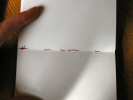

10.7 x 7.7 x 1.7 cm.
Notebook of white laid paper with deckle edges. Covers in black goatskin with red skiver doublures tooled in silver foil Spiral unsupported sewing pattern using Half-Hitch Millipede stitch in red thread.
This is the second binding I created after reading Exposed Spine Bindings by Keith Smith. I desinged it to address some of the problems I encountered with the Supported Spiral Notebook.
 I originally intended to use the Caterpillar stitch from Exposed Spine Bindings on this book. But, examining it more closely, I realised that it wasn't quite right for my purposes. It takes too many stages to get going, and the book gives no information on how you could make a sharp turn with the stitch. So I developed a variation, the Half-Hitch Millipede and figured out how to curve it. I don't intend to explain the stitch here; follow the links for step by step instructions.
I originally intended to use the Caterpillar stitch from Exposed Spine Bindings on this book. But, examining it more closely, I realised that it wasn't quite right for my purposes. It takes too many stages to get going, and the book gives no information on how you could make a sharp turn with the stitch. So I developed a variation, the Half-Hitch Millipede and figured out how to curve it. I don't intend to explain the stitch here; follow the links for step by step instructions.
To pre-punch the signatures, I drew a spiral on the spine. I then used a piece of card with marks showing the correct hole spacing to ensure that the millipede's "legs" would be the same length throughout the book. Then I simply sewed.
The first few signatures were the most difficult. Once the millipede bent back on itself, providing two sets of stitching, the book block stopped twisting and settled into an easy-to-handle shape. The half-hitches meant that I could be (and was) interrupted while stitching without having things unravel before I could pick the book up again.
I chose to do the asymmetric version of the millipede, because it's easier to make the turns.
Like with the Supported Spiral Notebook, I made the covers ahead of time by cutting them to the signature size (no squares) and covering them in leather. Unlike with the supported book, though, I had to attatch the covers before the entire book was completed, for continuity of the stitching.
To mark the covers, I noted where the curve of the spiral would need to start and finish. Then I pencilled in a pleasing curve, and used my card with the leg spacing to punch the paired holes along the line I'd marked.
When moving the stitching onto the boards, I ensured that the covers were closed, so that the body segment crossing the edge would be long enough. It means that there's a gap when the covers are open, and that the boards do shift easily.
Once the stitching crossed to the cover (the long body segment just meant tying more half-hitches in that step), it was simply a normal millipede stitch. Like with Keith Smith's Caterpillar, the millipede makes the transition from signature to cover easily.
As with the other book, I filled in the space within the turn-ins with 200 gsm card, which covered most of the thread on the inside of the cover. Again, I pressed the stitching that did show on the turn-ins into the leather with a bone folder.
The red skiver was cut just smaller than the boards, and glued down to hide the stitching on the turn-ins, particularly on the spine edges of the boards. I then tooled ith with silver foil, with the evil rooster maker's mark on the inside of the front cover and the small spiral on the inside of the back cover.
 Unlike with the supported version of this book, the unsupported notebook shows very little swell at the spine. This is because there is never more than one layer of thread at any given point in the middle of any signature.
Unlike with the supported version of this book, the unsupported notebook shows very little swell at the spine. This is because there is never more than one layer of thread at any given point in the middle of any signature.
 Although the sparse stitching prevents spine swell, it does introduce another problem. The signature with the most thread in it (this varies depending on how many turns of the spiral pass over the signature in question) has only 3 cm of stitching along its 10.5 cm length. The least-stitched signature has only 2 cm of stitching. This means that the pages may be prone to tearing out over time.
Although the sparse stitching prevents spine swell, it does introduce another problem. The signature with the most thread in it (this varies depending on how many turns of the spiral pass over the signature in question) has only 3 cm of stitching along its 10.5 cm length. The least-stitched signature has only 2 cm of stitching. This means that the pages may be prone to tearing out over time.
I don't think Smith addresses this problem in his description of the Caterpillar, but the issue will be the same for both types of stitch. Although it is not fatal to the book design, it is a factor to consider when choosing a stitching style.